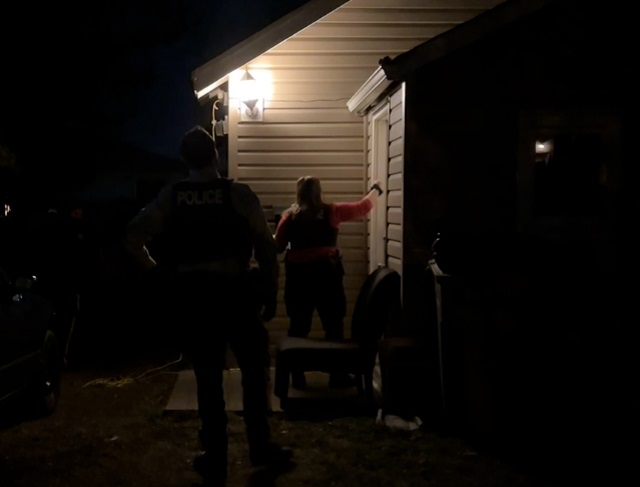Alberta
Operation ICE Tundra addresses child exploitation offences in Grande Prairie

News release from the Alberta Law Enforcement Response Team
Five child sexual exploitation suspects are facing charges as part of Operation ICE Tundra. ALERT Internet Child Exploitation (ICE) unit made the arrests in response to an increase in child sexual exploitation offences in Grande Prairie.
ICE executed a total of seven search warrants on seven homes with assistance from Grande Prairie RCMP between November 27-30, 2023. While the investigations were independent of one another, they shared the common thread of individuals uploading and accessing child sexual abuse material over the internet.
Operation ICE Tundra was initiated in October after investigators noticed an increase in case referrals originating from Grande Prairie. ICE receives case referrals from the RCMP’s National Child Exploitation Crime Center.
“An operation of this scale isn’t possible every day, but it’s important our unit creates a presence in smaller communities, showing that we will not tolerate this abuse against children. When these types of files are shared online, it’s the children who are the victims and are revictimized each time that file is shared,” said Sgt. Kerry Shima, ALERT ICE.
During the investigation, ICE relied on its Mobile Evidence Recovery Technology Lab (MERTL) to allow forensic technicians to rapidly conduct a preliminary analysis of electronic devices and computers seized from the homes.
“Our intention is always to support and protect the community and we recognize that throughout Alberta our job is to protect not only the community, but the children and vulnerable youth in the community. Grande Prairie should be assured that we’re up there working with them,” Shima added.
Full forensic analysis is ongoing, which may lead to additional arrests, charges, or the identification of potential victims.
To date, the following individuals have been charged with access, possession and transmitting child pornography in Operation ICE Tundra:
- Christopher Nanemahoo, 34-years old;
- Patrick L’Hirondelle, 29-years old;
- Stuart Kuechle, 36-years old;
- Naitram Ramnarane, 56-years old; and
- Dwayne Dyer, 46-years old.
Dyer is also being charged with firearms-related offences as three firearms inside his home were being unsafely stored.
ICE does not believe the suspects are known to one another, and the investigations do not appear to be connected.
ALERT was established and is funded by the Alberta Government and is a compilation of the province’s most sophisticated law enforcement resources committed to tackling serious and organized crime.
Alberta
Big win for Alberta and Canada: Statement from Premier Smith

Premier Danielle Smith issued the following statement on the April 2, 2025 U.S. tariff announcement:
“Today was an important win for Canada and Alberta, as it appears the United States has decided to uphold the majority of the free trade agreement (CUSMA) between our two nations. It also appears this will continue to be the case until after the Canadian federal election has concluded and the newly elected Canadian government is able to renegotiate CUSMA with the U.S. administration.
“This is precisely what I have been advocating for from the U.S. administration for months.
“It means that the majority of goods sold into the United States from Canada will have no tariffs applied to them, including zero per cent tariffs on energy, minerals, agricultural products, uranium, seafood, potash and host of other Canadian goods.
“There is still work to be done, of course. Unfortunately, tariffs previously announced by the United States on Canadian automobiles, steel and aluminum have not been removed. The efforts of premiers and the federal government should therefore shift towards removing or significantly reducing these remaining tariffs as we go forward and ensuring affected workers across Canada are generously supported until the situation is resolved.
“I again call on all involved in our national advocacy efforts to focus on diplomacy and persuasion while avoiding unnecessary escalation. Clearly, this strategy has been the most effective to this point.
“As it appears the worst of this tariff dispute is behind us (though there is still work to be done), it is my sincere hope that we, as Canadians, can abandon the disastrous policies that have made Canada vulnerable to and overly dependent on the United States, fast-track national resource corridors, get out of the way of provincial resource development and turn our country into an independent economic juggernaut and energy superpower.”
Alberta
Energy sector will fuel Alberta economy and Canada’s exports for many years to come

From the Fraser Institute
By any measure, Alberta is an energy powerhouse—within Canada, but also on a global scale. In 2023, it produced 85 per cent of Canada’s oil and three-fifths of the country’s natural gas. Most of Canada’s oil reserves are in Alberta, along with a majority of natural gas reserves. Alberta is the beating heart of the Canadian energy economy. And energy, in turn, accounts for one-quarter of Canada’s international exports.
Consider some key facts about the province’s energy landscape, as noted in the Alberta Energy Regulator’s (AER) 2023 annual report. Oil and natural gas production continued to rise (on a volume basis) in 2023, on the heels of steady increases over the preceding half decade. However, the dollar value of Alberta’s oil and gas production fell in 2023, as the surging prices recorded in 2022 following Russia’s invasion of Ukraine retreated. Capital spending in the province’s energy sector reached $30 billion in 2023, making it the leading driver of private-sector investment. And completion of the Trans Mountain pipeline expansion project has opened new offshore export avenues for Canada’s oil industry and should boost Alberta’s energy production and exports going forward.
In a world striving to address climate change, Alberta’s hydrocarbon-heavy energy sector faces challenges. At some point, the world may start to consume less oil and, later, less natural gas (in absolute terms). But such “peak” consumption hasn’t arrived yet, nor does it appear imminent. While the demand for certain refined petroleum products is trending down in some advanced economies, particularly in Europe, we should take a broader global perspective when assessing energy demand and supply trends.
Looking at the worldwide picture, Goldman Sachs’ 2024 global energy forecast predicts that “oil usage will increase through 2034” thanks to strong demand in emerging markets and growing production of petrochemicals that depend on oil as the principal feedstock. Global demand for natural gas (including LNG) will also continue to increase, particularly since natural gas is the least carbon-intensive fossil fuel and more of it is being traded in the form of liquefied natural gas (LNG).
Against this backdrop, there are reasons to be optimistic about the prospects for Alberta’s energy sector, particularly if the federal government dials back some of the economically destructive energy and climate policies adopted by the last government. According to the AER’s “base case” forecast, overall energy output will expand over the next 10 years. Oilsands output is projected to grow modestly; natural gas production will also rise, in part due to greater demand for Alberta’s upstream gas from LNG operators in British Columbia.
The AER’s forecast also points to a positive trajectory for capital spending across the province’s energy sector. The agency sees annual investment rising from almost $30 billion to $40 billion by 2033. Most of this takes place in the oil and gas industry, but “emerging” energy resources and projects aimed at climate mitigation are expected to represent a bigger slice of energy-related capital spending going forward.
Like many other oil and gas producing jurisdictions, Alberta must navigate the bumpy journey to a lower-carbon future. But the world is set to remain dependent on fossil fuels for decades to come. This suggests the energy sector will continue to underpin not only the Alberta economy but also Canada’s export portfolio for the foreseeable future.
-

 2025 Federal Election17 hours ago
2025 Federal Election17 hours agoMark Carney refuses to clarify 2022 remarks accusing the Freedom Convoy of ‘sedition’
-

 2025 Federal Election21 hours ago
2025 Federal Election21 hours agoPoilievre To Create ‘Canada First’ National Energy Corridor
-

 Bruce Dowbiggin19 hours ago
Bruce Dowbiggin19 hours agoAre the Jays Signing Or Declining? Only Vladdy & Bo Know For Sure
-

 2025 Federal Election20 hours ago
2025 Federal Election20 hours agoFixing Canada’s immigration system should be next government’s top priority
-

 Daily Caller18 hours ago
Daily Caller18 hours agoBiden Administration Was Secretly More Involved In Ukraine Than It Let On, Investigation Reveals
-

 2025 Federal Election2 days ago
2025 Federal Election2 days agoCanada Continues to Miss LNG Opportunities: Why the World Needs Our LNG – and We’re Not Ready
-

 Health2 days ago
Health2 days agoSelective reporting on measles outbreaks is a globalist smear campaign against Trump administration.
-

 2025 Federal Election2 days ago
2025 Federal Election2 days agoMark Carney is trying to market globalism as a ‘Canadian value.’ Will it work?



